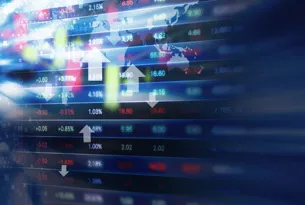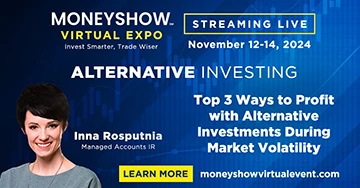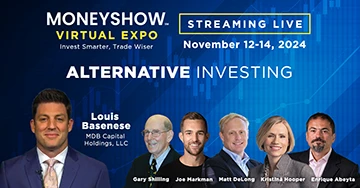Stephen Hammers of Compass EMP Funds discusses his firm’s five new equity indices that use risk weightings, rather than market cap. He uses some large-cap examples to explain how the indices work.
Kate Stalter: Today, my guest is Steve Hammers of Compass EMP Funds. Steve, you and I have talked several times before, but I know that you have some news today.
We typically have been talking about managed futures, but today you want to talk about some of your new volatility-weighted indexes. And these, as I understand it, are equity indexes. So can you begin by telling us why you launched these and why now?
Stephen Hammers: Yeah, we actually have several indexes on many different asset classes called the CEMP Volatility-Weighted Indexes. We released five. Dow Jones actually is publishing them and calculating them, the indexes.
We released five yesterday. That is: US Large Cap, US Small Cap, an international, and an emerging market, as well as a REIT.
The effect that these indexes have on the market, especially when you have other enhanced indexes out there that just focus on fundamentals, and the most popular indexes—like the S&P 500—focus on the cap weighting.
In my opinion, over the many, many years that I’ve been doing investing for institutions and mutual funds and so forth, most of the returns from these popular indexes, like the S&P 500, come from about 25% of the stocks. So you have very few stocks that contribute to the performance of these indexes.
So, for example, if you look at 2011, almost 80% of the return came from the top 25%. Most of the declines in the markets come from the top stocks in the S&P 500, because it puts all the weightings to the big names. That’s the problem.
Kate Stalter: Steve, to underscore what you are saying, there were several days earlier this year when you could actually track the performance of Apple (AAPL) and the performance of the S&P 500—just that one stock alone on some days.
Stephen Hammers: Yes, and mainly the Nasdaq, because Apple has had a significant weighting in the Nasdaq, and that is the problem with a lot of these indexes. And there’s trillions of dollars following it.
Even if you look at fundamental criteria—and I’m a huge fan of saying: If you’re going to be in this index, you’ve got to be making money. Period. Otherwise, you don’t even qualify for this index. But unlike some fundamental indexes out there that weight the stocks based on their earnings, we don’t. We weight the stock based on their risk contribution to the market, which is very, very unique.
I’ll give you a little example. You can’t take Amazon (AMZN) and Proctor & Gamble (PG) and say, “I’m going to weight based on how big you are, or weight them equally,” because they don’t have equal contribution to risk. Amazon is more volatile than Wal-Mart (WMT) is.
So in this index, if you want more broad exposure, you need to weight those both based on the contribution, so that both have the same return and risk contribution to the broad market; and that’s what this index does.
Kate Stalter: Can you give us a little more detail about the risk contribution? Are you talking about a stock’s beta, or is there some other measure you’re using?
Stephen Hammers: Definitely not beta, because beta includes correlation and volatility compared to something else. There are what’s called low-beta indexes. It just says I want to take all the betas of .8 or less. Well, that’s not the broad market.
This is the broad market, so let me give an example. If you have, going back to my example of Amazon and Proctor & Gamble: If Amazon has a standard deviation of volatility from the mean of 20%, Proctor & Gamble has a volatility of 10%, Amazon has twice the volatility of Proctor & Gamble. Well, how do you equalize that risk among all stocks in the market?
If I want the same risk of Proctor & Gamble and Wal-Mart, I have to reduce Amazon down and bring—well, in this case, Proctor & Gamble—up. So I may have a weighting of 5% in Amazon and 15% in Proctor & Gamble. In other words, two-thirds in Amazon and one-third in Proctor & Gamble.
Now they have the same risk, so now I can look at 500 stocks that represent the large-cap market, all making money, and every single stock in there has the weighting based on their volatility, so every stock is equalized in terms of risk.
Now what you get a much smoother return, a more consistent return. And in this case, for us, it has beat the S&P 500 ten out of the last 11 years; and if you go back that far—back to 2000—the S&P has increased only about 21%. Now this is ending March. But the CEMP US Large Cap 500 Volatility Weighted Index, which is what we’re talking about, is up 148%, compared to 21%. It’s a significant difference.
Why? It’s because a few stocks give you all the return in the S&P. And everybody’s trying to track those few stocks, and it’s making them bigger, and it’s kind of like the S&P 500 being a fad. Sometimes it’s overweight in technology, sometimes it is financials.
And this market has been so up and down in the last ten years that nobody’s really made any money. Why? It’s because of a few stocks, and it’s not because of the whole market. Although the industry thinks the S&P represents the broad market, I’m sorry. It doesn’t.
Kate Stalter: Let me follow up on that, because you were using the example of some of the large caps, Steve, and I wanted to just ask you whether those same criteria are applied to the other indexes that you’re launching.
Stephen Hammers: Yes, the exact same criteria, whether it’s small companies, large companies, international, emerging market. Even our indexes that we will have come out in about 30 days with Dow Jones—the commodity, and we have hedging indexes, other indexes that represent the broad market that take the indexing to another level.
So if most managers—fund managers, for example—in the last ten years, 70% of large-cap fund managers have not beaten the S&P. Why? Because they are trying to follow it and beat it, and because of their opinion, they don’t.
Well, 99.3% of active stock managers haven’t beat our CEMP indexes. It’s significant. Now you’ll never see a stock manager compare themselves to our indexes, but our indexes represent the broad market much better in terms of risk and productivity.
Related Reading:










































